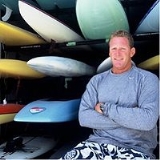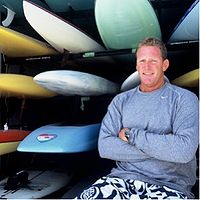
Paddleboarding
Encyclopedia
Paddleboarding is a surface water sport
in which the participant is propelled by a swimming motion usually on a long surfboard
close to the shore
. A derivative of paddleboarding is stand up paddle surfing
.
In 1926, while restoring historic Hawaiian boards for the Bernice P. Bishop Museum, Blake built a replica of the previously ignored olo surfboard ridden by ancient Hawaiian alii
(kings). He lightened his redwood replica (olo were traditionally made from wiliwili
wood) by drilling it full of holes and then covering them, creating the first ever hollow board as well as introducing the first modern paddleboard. Two years later,in 1928 using this same 16 ft (4.9 m), 120 lb (54.4 kg) board, Blake won the first ever Mainland surf contest, the Pacific Coast Surfriding Championships, an event integrating both surfing and paddling. Blake then returned to Hawaii to break virtually every established paddling record available, setting half-mile and 100-yard records that stood until 1955.
In 1932, using his drastically modified chambered hollow-board (now weighing roughly 60 lbs), which over the next decade he would tirelessly promote as a lifeguarding rescue tool, Blake out-paddled top California watermen Pete Peterson and Wally Burton in the first ever Mainland to Catalina crossing race (29 miles in 5 hours, 53 minutes). Over the next decade, Blake-influenced hollow boards (called “cigar boards” by reporters and later “kook boxes” by surfers) would be used in roughly equal proportion to solid plank boards for both paddling and surfing until the late ‘30s Hot Curl innovations led wave-riding in a new direction. For paddleboarding, however, the basic principles of Blake’s 1926 design remain relevant even today.
Paddleboarding experienced a renaissance in the early ‘80s after Los Angeles County lifeguard Rabbi Norm Shifren’s “Waterman Race” (22 Miles from Point Dume to Malibu) inspired surf journalist Craig Lockwood to begin production on a high quality stock paddleboard—known as the "Waterman." Its design, that has arguably won more races than any other stock paddleboard, remains a popular choice today. Shortly after, L.A, surfboard shaper Joe Bark and San Diego shaper Mike Eaton began production, and soon became two of the largest U.S. paddleboard makers, eventually producing nearly half of the estimated 3-400 paddleboards made each year in the U.S. today. L.A. lifeguards Gibby Gibson and Buddy Bohn revived the Catalina Classic event in 1982 for a field of 10 competitors. Concurrently in Hawaii, the annual Independence Day Paddleboard Race from Sunset to Waimea was drawing a few hundred competitors, many using surfboards due to lack of proper paddleboards on the Islands. As paddlers began ordering boards from the Mainland, local surfboard shapers like Dennis Pang (now one of
Hawaii’s largest paddleboard makers) moved quickly to fill the local niche. On both fronts, paddleboarding has been consistently gaining momentum and popularity.
, which are stronger and lighter than traditional fiberglass. Cost of new boards range from $1,500 to $3,000 for custom boards. Used boards that have been well kept are in high demand and can be sold fairly easily on paddleboard listing web sites.
Paddles are used to propel Paddleboards. Their pricing ranges from $100 to $400. Some are made out of wood, epoxy, fiber glass, and/or carbon fiber.

Surface water sports
The following is a list of surface water sports; these are sports which are performed atop a body of water.-Discing:Discing consists of standing on a circular wooden disc and being towed behind the boat. The disc supports the rider by means of spreading the weight out evenly across the water...
in which the participant is propelled by a swimming motion usually on a long surfboard
Surfboard
A surfboard is an elongated platform used in the sport of surfing. Surfboards are relatively light, but are strong enough to support an individual standing on them while riding a breaking wave...
close to the shore
Shore
A shore or shoreline is the fringe of land at the edge of a large body of water, such as an ocean, sea, or lake. In Physical Oceanography a shore is the wider fringe that is geologically modified by the action of the body of water past and present, while the beach is at the edge of the shore,...
. A derivative of paddleboarding is stand up paddle surfing
Stand up paddle surfing
Stand up paddle surfing , or in the Hawaiian language Hoe he'e nalu, is an emerging global sport with a Hawaiian heritage. The sport is an ancient form of surfing, and reemerged as a way for surfing instructors to manage their large groups of students, as standing on the board gave them a higher...
.
History
Thomas Edward Blake is credited as the pioneer in paddleboard construction in the early 1930s.In 1926, while restoring historic Hawaiian boards for the Bernice P. Bishop Museum, Blake built a replica of the previously ignored olo surfboard ridden by ancient Hawaiian alii
Ali'i
Alii is a word in the Polynesian language denoting chiefly status in ancient Hawaii and the Samoa Islands. A similar word with the same concept is found in other Polynesian societies. In the Cook Islands, an ariki is a high chief and the House of Ariki is a parliamentary house...
(kings). He lightened his redwood replica (olo were traditionally made from wiliwili
Wiliwili
Wiliwili is a species of flowering tree in the pea family, Fabaceae that is endemic to the Hawaiian Islands. It is the only species of Erythrina that naturally occurs there. It is typically found in dry forests on leeward island slopes up to an elevation of .Wiliwili is occasionally seen in...
wood) by drilling it full of holes and then covering them, creating the first ever hollow board as well as introducing the first modern paddleboard. Two years later,in 1928 using this same 16 ft (4.9 m), 120 lb (54.4 kg) board, Blake won the first ever Mainland surf contest, the Pacific Coast Surfriding Championships, an event integrating both surfing and paddling. Blake then returned to Hawaii to break virtually every established paddling record available, setting half-mile and 100-yard records that stood until 1955.
In 1932, using his drastically modified chambered hollow-board (now weighing roughly 60 lbs), which over the next decade he would tirelessly promote as a lifeguarding rescue tool, Blake out-paddled top California watermen Pete Peterson and Wally Burton in the first ever Mainland to Catalina crossing race (29 miles in 5 hours, 53 minutes). Over the next decade, Blake-influenced hollow boards (called “cigar boards” by reporters and later “kook boxes” by surfers) would be used in roughly equal proportion to solid plank boards for both paddling and surfing until the late ‘30s Hot Curl innovations led wave-riding in a new direction. For paddleboarding, however, the basic principles of Blake’s 1926 design remain relevant even today.
Paddleboarding experienced a renaissance in the early ‘80s after Los Angeles County lifeguard Rabbi Norm Shifren’s “Waterman Race” (22 Miles from Point Dume to Malibu) inspired surf journalist Craig Lockwood to begin production on a high quality stock paddleboard—known as the "Waterman." Its design, that has arguably won more races than any other stock paddleboard, remains a popular choice today. Shortly after, L.A, surfboard shaper Joe Bark and San Diego shaper Mike Eaton began production, and soon became two of the largest U.S. paddleboard makers, eventually producing nearly half of the estimated 3-400 paddleboards made each year in the U.S. today. L.A. lifeguards Gibby Gibson and Buddy Bohn revived the Catalina Classic event in 1982 for a field of 10 competitors. Concurrently in Hawaii, the annual Independence Day Paddleboard Race from Sunset to Waimea was drawing a few hundred competitors, many using surfboards due to lack of proper paddleboards on the Islands. As paddlers began ordering boards from the Mainland, local surfboard shapers like Dennis Pang (now one of
Hawaii’s largest paddleboard makers) moved quickly to fill the local niche. On both fronts, paddleboarding has been consistently gaining momentum and popularity.
Equipment
Paddleboarding can be done on various pieces of equipment, including surfboards. Paddleboards are made of fiberglass, epoxy, and/or carbon fiber and are generally quite large (ranging from eight feet to fourteen feet). Most modern paddleboards are made of polyurethane foam (with one or more wooden strips or "stringers"), fiberglass cloth, and polyester resin. An emerging paddleboard technology is an epoxy surfboardSurfboard
A surfboard is an elongated platform used in the sport of surfing. Surfboards are relatively light, but are strong enough to support an individual standing on them while riding a breaking wave...
, which are stronger and lighter than traditional fiberglass. Cost of new boards range from $1,500 to $3,000 for custom boards. Used boards that have been well kept are in high demand and can be sold fairly easily on paddleboard listing web sites.
Paddles are used to propel Paddleboards. Their pricing ranges from $100 to $400. Some are made out of wood, epoxy, fiber glass, and/or carbon fiber.
Notable events
- Santa Monica Pier Paddleboard Race and Ocean Festival (6 miles and 2 miles)
- Molokai to Oahu Paddleboard Race (32 Miles from Kaluakoi, Molokai to Hawaii Kai, Oahu)
- Catalina Classic (32 Miles from Catalina to Manhattan Beach)
- Hennessey's International Paddleboard Championship (12 Miles)
- Maui International Paddleboard Race (9 Miles)
- Hamilton Island CupHamilton Island CupSet against the backdrop of the Whitsunday Islands, on Queensland's Great Barrier Reef - Hamilton Island Cup has evolved to become a 4 day multi-disciplined outigger paddling regatta and Australia's premier outrigger canoeing event.- History :...
- Australia (8 Kilometres) - "Full Moon" paddles from Cuba to the USA (105 miles)
Famous paddleboarding spots
Some of the best known surf breaks:- Hermosa Beach, CaliforniaHermosa Beach, CaliforniaHermosa Beach is a beachfront city in Los Angeles County, California, United States. Its population was 19,506 at the 2010 census, up from 18,566 at the 2000 census....
- Manhattan Beach, CaliforniaManhattan Beach, CaliforniaManhattan Beach is the wealthiest beachfront city located in southwestern Los Angeles County, California, USA. The city is on the Pacific coast, south of El Segundo, and north of Hermosa Beach. Manhattan Beach is the home of both beach and indoor volleyball, and surfing. During the winter, the...
- San Diego, CaliforniaSan Diego, CaliforniaSan Diego is the eighth-largest city in the United States and second-largest city in California. The city is located on the coast of the Pacific Ocean in Southern California, immediately adjacent to the Mexican border. The birthplace of California, San Diego is known for its mild year-round...
- HawaiiHawaiiHawaii is the newest of the 50 U.S. states , and is the only U.S. state made up entirely of islands. It is the northernmost island group in Polynesia, occupying most of an archipelago in the central Pacific Ocean, southwest of the continental United States, southeast of Japan, and northeast of...
- Santa Monica PierSanta Monica PierThe Santa Monica Pier is a large double-jointed pier located at the foot of Colorado Avenue in Santa Monica, California and is a prominent, 100-year-old landmark.-Pacific Park:...
Notable paddleboarders

- Jamie Mitchell - 9 Time Winner of Molokai & Catalina Races
- Kyle Daniels - Only man to beat Jamie Mitchell, Catalina Classic Winner, Manhattan Beach Ocean Lifeguard Specialist, Sponsored by Bark Paddleboards
- Thomas Michael O'Shaughnessy, Jr.Thomas Michael O'Shaughnessy, Jr.Thomas Michael O'Shaughnessy, Jr., born Fort Bragg, North Carolina 10-17-1956, living in Ponce Inlet, Florida is a member of the UCF Athletics Hall of Fame , a Paddleboarder/Surfer, Adventurer, Real Estate and Philanthropist....
- Guinness World Record paddleboarding the English Channel; created the East Coast Paddleboard Championships held yearly in Ponce Inlet. (2) - Brian Murphy - Many Stock Division Wins, Many National Lifeguard Championship medals, sponsored by Force Field
- Chris Owens - The first person, since Gene "Tarzan" Smith in 1940, to paddleboard from Oahu to Kauai who remains the only living person to do so.

